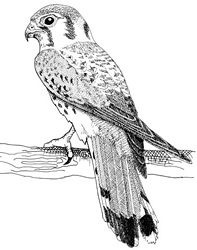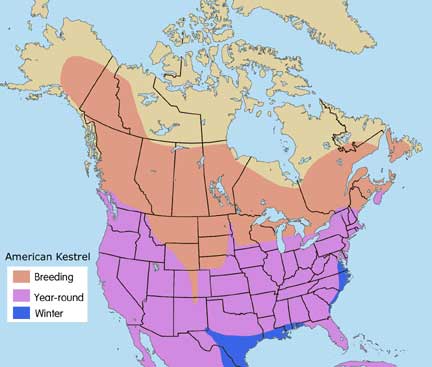
Scientific Name: Falco sparverius
The most common and widespread falcon in North America, as well as the smallest and most delicate. Having the typical falcon shape — a short neck, relatively small head, long and slender pointed wings, and a long tail – gives this bird a streamlined body designed for fast flight. Females are slightly larger than males, but unlike most birds of prey, the sexes have different plumages. Both have a rufous-red back and tail, double black stripes on white cheeks, and a gray head with a rufous crown patch. Wing color and pattern is the most noticeable difference: females have rufous barred upper wings, while males have wings of blue-gray with small black spots, with a row of white circles on a darker trailing wing edge. Flight of this small falcon is light and buoyant, with rapid, shallow wingbeats and short glides. Often seen in flight with the wingtips swept back, or hovering motionless in midair over prey. Head bobbing, and flicking the tail up and down are two commonly observed behaviors when this bird is perched.
Male
Length: 8 – 10″
Wingspan: 20 – 22″
Weight: 3.4 – 4.5 oz.
Female
Length: 9 – 11″
Wingspan: 21 – 24″
Weight: 3.6 – 5.3 oz.
Status – State and federally protected
Habitat – Most often seen in open fields or pasture lands with scattered trees, woodland edges, and along highways – where scattered high perches near open land provide good hunting. This very versatile species can take advantage of a variety of habitats, from mountain meadows to desert plains and canyons. Within the breeding range, will be found wherever there are enough perches, nest sites, and open vegetation to support a food supply for their prey species.
Diet – Consists primarily of insects and rodents, other small mammals, and reptiles; small birds are also taken, mostly in winter when other prey are not as plentiful. Often hovers over prey before swooping down; hunts mostly in the morning and late afternoon, perching quietly at other times of the day. In summertime, grasshoppers and crickets will form much of the diet in many areas.
Call – With a voice higher in pitch than that of other raptors, kestrels will frequently give a shrill call of killykillykilly, or a screaming cry of kliklikliklikli.
Nesting – Likes old tree nesting holes of other bird species, tree hollows, holes in cliffs, in wall niches or under eaves in urban environments. Can be attracted to manmade nest boxes.
Most Common Problems – Collisions with vehicles or windows. Because these birds are willing to live close to humans, young often fledge into dangerous areas, such as manufacturing plants or lumber yards.


Ranges from western Alaska across central Canada, throughout the United States, south into Mexico, parts of the Caribbean and Central America, and into most of South America. In North America, the wintering range contracts into most of the USA except for the Northern Great Plains and Northern Rockies.
Special Thanks for range maps:
Dan Gleason
BGleason Design & Illustration
Commercial & Scientific Illustration, Graphic Design
CraneDance Communications
Book Production/Design

